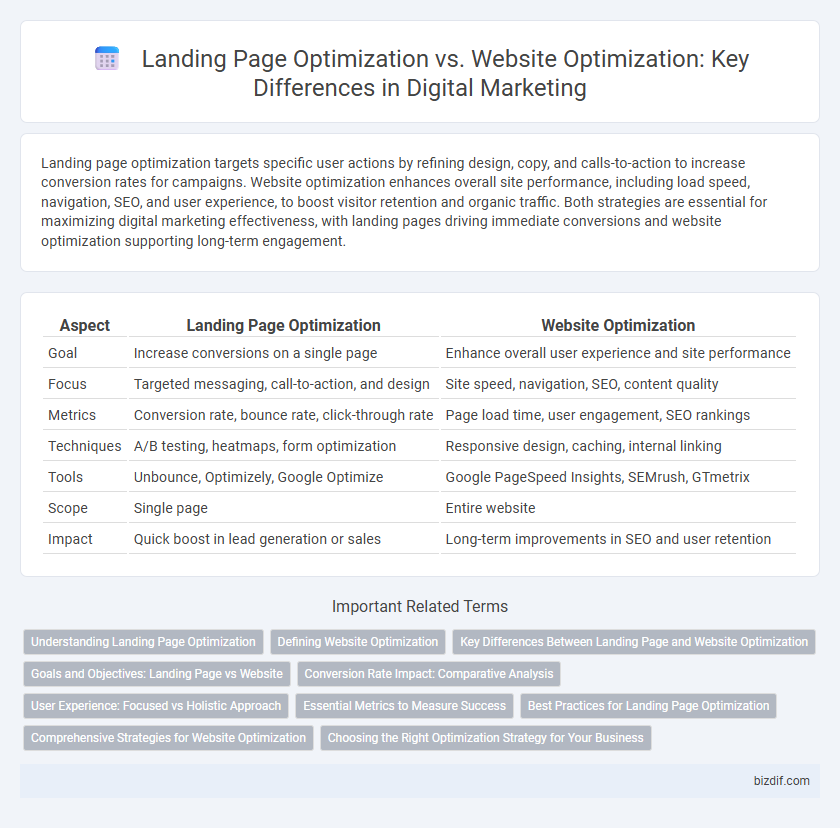Landing page optimization targets specific user actions by refining design, copy, and calls-to-action to increase conversion rates for campaigns. Website optimization enhances overall site performance, including load speed, navigation, SEO, and user experience, to boost visitor retention and organic traffic. Both strategies are essential for maximizing digital marketing effectiveness, with landing pages driving immediate conversions and website optimization supporting long-term engagement.
Table of Comparison
| Aspect | Landing Page Optimization | Website Optimization |
|---|---|---|
| Goal | Increase conversions on a single page | Enhance overall user experience and site performance |
| Focus | Targeted messaging, call-to-action, and design | Site speed, navigation, SEO, content quality |
| Metrics | Conversion rate, bounce rate, click-through rate | Page load time, user engagement, SEO rankings |
| Techniques | A/B testing, heatmaps, form optimization | Responsive design, caching, internal linking |
| Tools | Unbounce, Optimizely, Google Optimize | Google PageSpeed Insights, SEMrush, GTmetrix |
| Scope | Single page | Entire website |
| Impact | Quick boost in lead generation or sales | Long-term improvements in SEO and user retention |
Understanding Landing Page Optimization
Landing page optimization focuses on improving specific landing pages to increase conversion rates by enhancing elements such as headlines, calls to action, and user experience tailored to targeted campaigns. Website optimization encompasses a broader scope, including overall site performance, navigation, and SEO to boost traffic and engagement across all pages. Understanding landing page optimization is crucial for digital marketing, as it directly impacts lead generation and sales by aligning content and design with user intent.
Defining Website Optimization
Website optimization involves improving various elements of a website to enhance user experience, increase traffic, and boost conversion rates through techniques such as improving site speed, mobile responsiveness, and SEO. It encompasses both technical aspects like optimizing server performance and content-related tasks such as keyword integration and A/B testing for user engagement. Focusing on comprehensive website optimization ensures that all pages, including landing pages, perform efficiently to meet broader business goals.
Key Differences Between Landing Page and Website Optimization
Landing page optimization targets improving conversion rates by focusing on a single call-to-action, simplified design, and specific content tailored to visitor intent, while website optimization enhances overall user experience, navigation, and performance across multiple pages to boost engagement and search engine rankings. Key differences include the scope, with landing pages being standalone destinations optimized for lead generation or sales, whereas websites require holistic optimization covering SEO, speed, usability, and content strategy. Metrics for landing pages emphasize conversion rate and bounce rate, whereas website optimization tracks session duration, pages per session, and organic traffic growth.
Goals and Objectives: Landing Page vs Website
Landing page optimization concentrates on driving specific conversions such as lead generation or sales by tailoring content and design to a targeted audience segment. Website optimization focuses on improving overall user experience, site speed, and SEO to enhance broad engagement and organic traffic across multiple pages. The primary goal of landing page optimization is maximizing conversion rates for a single campaign, while website optimization aims to increase long-term visibility and retention.
Conversion Rate Impact: Comparative Analysis
Landing page optimization targets specific user actions by refining design, content, and call-to-actions to significantly boost conversion rates for targeted campaigns. Website optimization addresses broader site performance, usability, and SEO, improving overall user experience and organic traffic but with a more diluted impact on immediate conversions. Focusing on landing page elements often yields higher conversion rate improvements compared to generalized website changes due to its direct alignment with user intent and campaign goals.
User Experience: Focused vs Holistic Approach
Landing page optimization targets a focused user experience by streamlining specific calls to action, ensuring visitors complete desired goals with minimal distractions. Website optimization adopts a holistic approach, enhancing overall site performance, navigation, and content to create a cohesive and engaging user journey across multiple pages. Prioritizing landing page optimization maximizes conversion rates in campaigns, while website optimization improves long-term user satisfaction and retention.
Essential Metrics to Measure Success
Landing page optimization centers on improving conversion rates by analyzing key metrics such as bounce rate, click-through rate (CTR), and form submission rate, which directly reflect user engagement and lead generation effectiveness. Website optimization takes a broader approach, measuring metrics like overall site traffic, page load speed, and average session duration to enhance user experience and search engine rankings. Tracking these essential metrics allows marketers to identify performance gaps and prioritize improvements that drive higher ROI across both landing pages and full websites.
Best Practices for Landing Page Optimization
Landing page optimization focuses on enhancing specific key elements such as headlines, call-to-action buttons, and loading speed to increase conversion rates. Best practices include A/B testing design variations, using clear and concise messaging, and minimizing distractions to direct user attention toward the desired action. These tactics differ from broad website optimization, which aims to improve overall user experience and site performance across multiple pages.
Comprehensive Strategies for Website Optimization
Comprehensive website optimization involves enhancing the entire site's user experience, speed, mobile responsiveness, and SEO structure to drive higher engagement and conversion rates beyond just isolated landing pages. Unlike landing page optimization, which focuses on specific entry points, website optimization integrates technical SEO, content quality, and site architecture improvements to create a cohesive digital presence that supports long-term growth. Employing analytics tools and A/B testing across all pages ensures consistent performance enhancements and maximizes overall marketing ROI.
Choosing the Right Optimization Strategy for Your Business
Landing page optimization concentrates on improving a specific page's conversion rate by refining content, design, and call-to-action elements to target campaign goals effectively. Website optimization involves enhancing overall site performance, user experience, and SEO to increase organic traffic and engagement across multiple pages. Choosing the right optimization strategy depends on your business objectives, whether driving immediate conversions through focused landing pages or building long-term brand authority with comprehensive website improvements.
Landing page optimization vs Website optimization Infographic

 bizdif.com
bizdif.com